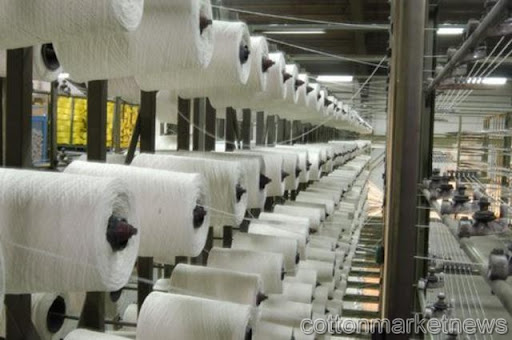Monday, March 28, 2011
Cotton Rally Peaking as Record Crop Means First Stockpile Gain Since 2007
The rally that drove the price of cotton to the highest since the U.S. was recovering from the Civil War is winding down as farmers from Texas to New South Wales record harvests of plants and replenish stocks for the first time since 2007.
The cotton will be reduced 51 percent to $ 1 a pound, 31 December, according to the median of a Bloomberg survey of 14 analysts and traders. Hedge funds are already cutting bets on higher prices for most of the last three years. The output may increase by 11 percent to 127.5 million bales in the year beginning August 1 three times faster than a 3 percent increase in demand to 120 million bales, U.S. Department of Agriculture estimates. A bale of 480 pounds is sufficient for 215 pairs of jeans.
"We had a beautiful race, and I see that maintained," said John Stephenson, who helps manage more than C $ 2 million (U.S. $ 2 billion) at First Asset Investment Management Inc. in Toronto. "More area will be devoted to cotton, and in a scenario where consumers face higher prices for food and fuel, clothing in the background."
Cotton rose to $ 2,197 on March 7, the highest in 140 years of trading in New York after floods in Australia and Pakistan and frost in the cultures of China in ruins. Adidas AG (ADS), the sporting goods second major, said this month that the cotton was threatening cost margins, and Wal-Mart Stores Inc. (WMT), the world's largest retailer, paid more than clothing clothing like jeans.
Food costs
Farmers are responding by planting more cotton, which may come at the expense of corn and soybeans, Stephenson said active first. Corn gained 79 percent since July 1 and soybeans rose 50 percent, boosting the global cost of food to a record, the United Nations estimates. An extra 44 million people were expelled in "extreme poverty" since June, according to the World Bank, and riots spread across North Africa and the Middle East, toppling the leaders of Egypt and Tunisia.
While March 7 marked the peak, which is much lower than in previous decades. In 1973, cotton climbed to its highest in at least 14 years to 99 cents, equivalent to $ 4.92 today, according to a calculator on the website of the Federal Reserve Bank of Minneapolis.
Cotton closed at $ 2.0449 on March 25, after rising 178 percent since mid-July, most of the 24 commodities in the Standard & Poor's GSCI. The indicator of raw materials rose 42 percent, to 500 from Standard & Poor's has increased by 20 percent and Treasury bonds lost 0.2 percent, a Bank of America shows the rate of Merrill Lynch. Cotton fell by the maximum exchange of 7 cents, or 3.4 percent, to settle at 1.9749 dollars per pound today.
Money managers
Hedge funds and other money managers cut bets on rising prices by 64 percent from a peak in September, the biggest drop since 2008. Betting declined for seven consecutive weeks, the longest streak since at least June 2006, and the total of 29,185 contracts, U.S. Commodity Futures Trading Commission data show. A contract is equal to 50,000 pounds.
Future anticipated a fall in December of $ 1.2792, according to U.S. ICE Futures. The costs do not fall to the $ 1 under the Bloomberg survey until October 2012, according to the data.
Even $ 1 would be 64 percent higher than the average of 10 years of 61.16 cents. Inventories in warehouses monitored by ICE U.S. dropped 81 percent since June and in October fell to its lowest level since at least August 2002.
"World plantations are set to expand impressive this year," said Gary Raines, an economist at FCStone Fibers and Textiles in Nashville, Tennessee. "Even if demand overshadow mill production, the difference may not be enough to rebuild global inventories enough to pull prices down to long-term average in just one campaign."
Extreme weather
Prices could still join $ 2.30 in June because supply is so scarce and more "weather problems or other external disasters" could mean a maximum of $ 2.90, said John Flanagan, president of Flanagan Trading Corp. in Fuquay-Varina , North Carolina.
Demand continues to be strengthening. In the year ending July 31, China used 17.5 million more bullets than it grows, the USDA estimates. China's economy will expand 9.5 percent this year, more than three times the U.S. growth and the euro zone, according to the median estimate of up to 68 economists compiled by Bloomberg.
While farmers will grow more cotton this year, not all can reach world markets. India's second largest producer after China, exports of cotton yarn, Limited in December due to concerns about domestic shortages. Eased some of those restrictions last month.
Farm Income
The increase in prices of the same that is helping to drive U.S. farm profits by 20 percent to a record 94.7 billion U.S. dollars is hurting manufacturers, retailers and consumers.
The "headwinds in the calculation of costs, especially in cotton in Asia, will affect everyone," said Myron E. Ullman, chairman and CEO of JC Penney Co., the third largest U.S. department store, March 9. Gap Inc. (GPS), the largest U.S. clothing chain, is facing similar problems, President and CEO Glenn K. Murphy said in a conference call the same day.
Raw materials costs, labor and transportation are the creation of "a gross margin headwind," said Herbert Hainer, CEO of Herzogenaurach, Adidas, based in Germany, in a conference call on March 2. Nike Inc. (NKE), the largest sporting goods company, began to see the impact in the third quarter, Chief Financial Officer Don Blair said in a conference call two weeks later.
Wal-Mart, based in Bentonville, Arkansas, has already paid more for some cotton garments such as jeans, and "we are told that by the end of this year, there will be much more" up, William Simon, President and CEO of Wal -Mart U.S., said in a conference call on March 10.
Textile manufacturers
Some U.S. textile manufacturers are canceling orders or synthetic fibers using more concern that it will not be able to pass costs to customers, "said Cass Johnson, president of the Washington-based National Council of Textile Organizations, which has more than 80 companies as members.
share of cotton in the world textile market will be reduced to about 30 percent by 2020 from about 37 percent as mills switch to synthetics, according to the International Cotton Advisory Committee. The Washington-based group has 43 members.
Best Western International Inc., the largest hotel chain in the rooms, said he is paying 53 percent more for towels a year ago. Requests for towels and sheets can take up to two months to complete, compared to normal two weeks, the company said in a reply to questions sent.
In the year commencing on 1 August, the world cotton acreage will increase by 7.9 percent to 36 million hectares (89 million acres), the largest in 16 years, according to the committee.
Major Exporter
Production in the U.S. , The largest exporter, will increase 6.6 percent to 19.5 million bales in the following year, as estimated by the USDA. India's output may reach record levels, according to Bhadresh Trading Corp., the largest exporter in the nation. Production in Australia, the fourth largest exporter, may also increase to a record, the Australian Bureau of Agricultural and Resource Economics and prognosis of Sciences March 1.
At the end of the following year, in July 2012, global stocks may have increased by 18 percent to 50 million bales, according to the USDA.
"The prices are exaggerated, and shortages in the market has been exaggerated," said Christoph Eibl, co-founder of Zug, Switzerland-based Tiberius Group, a fund manager overseeing more than $ 2 billion. "The market has taken a lot of speculators and this is not sustainable."

This post was written by: HaMienHoang (admin)
Click on PayPal buttons below to donate money to HaMienHoang:
Follow HaMienHoang on Twitter










0 Responses to “Cotton Rally Peaking as Record Crop Means First Stockpile Gain Since 2007”
Post a Comment